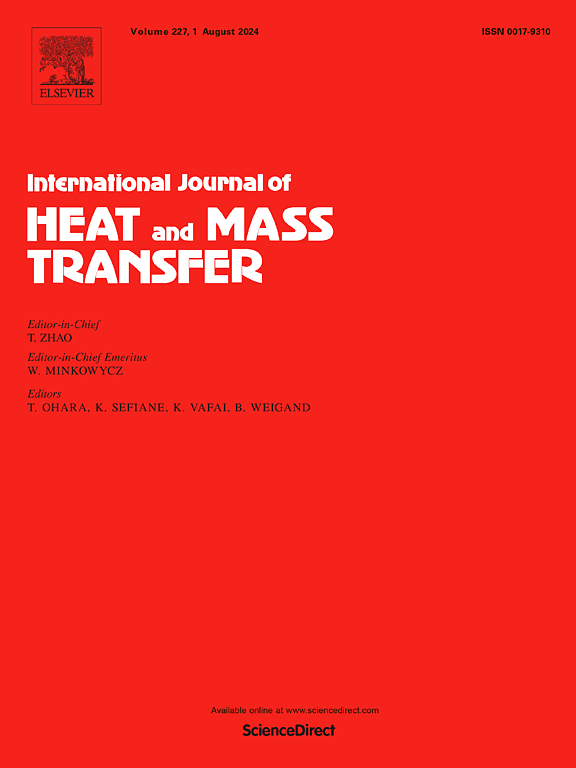Predictions of Line Chilldown Boiling Regime Transitions by a Coupled CFD-Subgrid Boiling Model Validated against 1G LN2 Experiments
IF 5.8
2区 工程技术
Q1 ENGINEERING, MECHANICAL
International Journal of Heat and Mass Transfer
Pub Date : 2024-12-02
DOI:10.1016/j.ijheatmasstransfer.2024.126385
引用次数: 0
Abstract
Before filling a propellant tank on the ground or in Space, the transfer line between the donor and receiver tanks must be cooled down, preferably while sacrificing the least amount of the cryogenic fluid. The cryogenic line chill-down process involves transitions between different flow boiling regimes, namely film boiling, transition film boiling, and nucleate boiling, which are complex and gravity-dependent. Attempts to capture these boiling phenomena and to predict the transitions between them in a Computational Fluid Dynamics (CFD) framework are new and challenging. The present work addresses this challenge by following an Eulerian approach in which a homogeneous two-phase mixture model is used together with the Lee phase change formulation to capture the chilldown film boiling regime in the framework of the ANSYS Fluent® CFD code. The chilldown nucleate boiling regime is predicted by a mechanistic subgrid model that accounts for the nucleation, growth, departure diameter, and shedding frequency of the bubbles. The subgrid model is encoded and coupled to the CFD model via a user-defined function for the wall-fluid heat flux calculations. The coupled CFD-Subgrid model is validated against published experimental data for the chill-down of a heated stainless-steel pipe in 1g using liquid nitrogen (LN2). The CFD predictions of the wall temperature evolution, rewetting temperature, and transition between film and nucleate boiling agree well with experimental measurements for LN2 flow in a vertical pipe. Physical insights derived from the CFD simulations and validation are described, and the strengths and weaknesses of the modeling approach are presented and discussed. Recommendations for future improvements of the CFD model are also provided.
通过1G LN2实验验证的耦合cfd -亚网格沸腾模型预测线冷却沸腾状态转变
在地面或太空中加注推进剂储罐之前,必须冷却供体和接收储罐之间的传输管道,最好是在牺牲最少量的低温流体的同时进行。低温线冷却过程涉及不同沸腾状态之间的转换,即膜沸腾、过渡膜沸腾和核沸腾,这是一个复杂的、依赖于重力的过程。试图在计算流体动力学(CFD)框架中捕捉这些沸腾现象并预测它们之间的过渡是一项新的挑战。目前的工作通过遵循欧拉方法解决了这一挑战,在该方法中,均匀的两相混合模型与Lee相变公式一起使用,以捕获ANSYS Fluent®CFD代码框架中的冷却膜沸腾状态。冷却核沸腾状态是由一个机械亚网格模型来预测的,该模型考虑了气泡的成核、生长、偏离直径和脱落频率。对子网格模型进行编码,并通过用户定义的壁面流体热流密度计算函数与CFD模型耦合。利用已发表的液氮(LN2)对加热不锈钢管在1g中冷却的实验数据验证了耦合CFD-Subgrid模型。壁面温度演变、再润湿温度以及膜沸腾和核沸腾转变的CFD预测结果与LN2在垂直管内流动的实验结果吻合较好。描述了从CFD模拟和验证中获得的物理见解,并提出和讨论了建模方法的优缺点。本文还对今后CFD模型的改进提出了建议。
本文章由计算机程序翻译,如有差异,请以英文原文为准。
求助全文
约1分钟内获得全文
求助全文
来源期刊
CiteScore
10.30
自引率
13.50%
发文量
1319
审稿时长
41 days
期刊介绍:
International Journal of Heat and Mass Transfer is the vehicle for the exchange of basic ideas in heat and mass transfer between research workers and engineers throughout the world. It focuses on both analytical and experimental research, with an emphasis on contributions which increase the basic understanding of transfer processes and their application to engineering problems.
Topics include:
-New methods of measuring and/or correlating transport-property data
-Energy engineering
-Environmental applications of heat and/or mass transfer

 求助内容:
求助内容: 应助结果提醒方式:
应助结果提醒方式:


